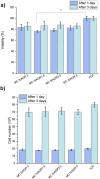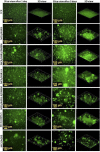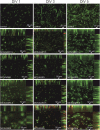A methylcellulose/agarose hydrogel as an innovative scaffold for tissue engineering
- PMID: 36320849
- PMCID: PMC9490780
- DOI: 10.1039/d2ra04841h
A methylcellulose/agarose hydrogel as an innovative scaffold for tissue engineering
Abstract
In situ crosslinked materials are the main interests of both scientific and industrial research. Methylcellulose (MC) aqueous solution is one of the representatives that belongs to this family of thermosensitive materials. At room temperature, MC is a liquid whereupon during temperature increase up to 37 °C, it crosslinks physically and turns into a hydrogel. This feature makes it unique, especially for tissue engineering applications. However, the crosslinking rate of MC alone is relatively slow considering tissue engineering expectations. According to these expectations, the crosslinking should take place slowly enough to allow for complete injection and fill the injury avoiding clogging in the needle, and simultanously, it should be sufficiently fast to prevent it from relocation from the lesion. One of the methods to overcome this problem is MC blending with another substance that increases the crosslinking rate of MC. In these studies, we used agarose (AGR). These studies aim to investigate the effect of different AGR amounts on MC crosslinking kinetics, and thermal, viscoelastic, and biological properties. Differential Scanning Calorimetry (DSC) and dynamic mechanical analysis (DMA) measurements proved that AGR addition accelerates the beginning of MC crosslinking. This phenomenon resulted from AGR's greater affinity to water, which is crucial in this particular crosslinking part. In vitro tests, carried out using the L929 fibroblast line and mesenchymal stem cells (MSCs), confirmed that most of the hydrogel samples were non-cytotoxic in contact with extracts and directly with cells. Not only does this type of thermosensitive hydrogel system provide excellent mechanical and biological cues but also its stimuli-responsive character provides more novel functionalities for designing innovative scaffold/cell delivery systems for tissue engineering applications.
This journal is © The Royal Society of Chemistry.
Conflict of interest statement
There are no conflicts to declare.
Figures










Similar articles
-
Crosslinking Kinetics of Methylcellulose Aqueous Solution and Its Potential as a Scaffold for Tissue Engineering.Polymers (Basel). 2019 Oct 28;11(11):1772. doi: 10.3390/polym11111772. Polymers (Basel). 2019. PMID: 31661795 Free PMC article.
-
Methylcellulose/agarose hydrogel loaded with short electrospun PLLA/laminin fibers as an injectable scaffold for tissue engineering/3D cell culture model for tumour therapies.RSC Adv. 2023 Apr 17;13(18):11889-11902. doi: 10.1039/d3ra00851g. eCollection 2023 Apr 17. RSC Adv. 2023. PMID: 37077262 Free PMC article.
-
Dual-crosslinked methylcellulose hydrogels for 3D bioprinting applications.Carbohydr Polym. 2020 Jun 15;238:116192. doi: 10.1016/j.carbpol.2020.116192. Epub 2020 Mar 23. Carbohydr Polym. 2020. PMID: 32299570
-
Crosslinking strategies in modulating methylcellulose hydrogel properties.Soft Matter. 2023 Oct 25;19(41):7869-7884. doi: 10.1039/d3sm00721a. Soft Matter. 2023. PMID: 37817578 Review.
-
Thermo-Responsive Methylcellulose Hydrogels: From Design to Applications as Smart Biomaterials.Tissue Eng Part B Rev. 2021 Oct;27(5):486-513. doi: 10.1089/ten.TEB.2020.0202. Epub 2020 Dec 8. Tissue Eng Part B Rev. 2021. PMID: 33115329 Review.
Cited by
-
Impact of Thermo-Responsive N-Acetylcysteine Hydrogel on Dermal Wound Healing and Oral Ulcer Regeneration.Int J Mol Sci. 2024 Apr 29;25(9):4835. doi: 10.3390/ijms25094835. Int J Mol Sci. 2024. PMID: 38732054 Free PMC article.
-
Oxygen-controllable injectable hydrogel alleviates intervertebral disc degeneration by balancing extracellular matrix metabolism.Mater Today Bio. 2024 Sep 14;29:101252. doi: 10.1016/j.mtbio.2024.101252. eCollection 2024 Dec. Mater Today Bio. 2024. PMID: 39624048 Free PMC article.
-
Building Fucoidan/Agarose-Based Hydrogels as a Platform for the Development of Therapeutic Approaches against Diabetes.Molecules. 2023 Jun 2;28(11):4523. doi: 10.3390/molecules28114523. Molecules. 2023. PMID: 37298999 Free PMC article.
-
Agarose Hydrogels for Bone Tissue Engineering, from Injectables to Bioprinting.Gels. 2025 Mar 28;11(4):255. doi: 10.3390/gels11040255. Gels. 2025. PMID: 40277691 Free PMC article. Review.
-
Hydrogel promotes bone regeneration through various mechanisms: a review.Biomed Tech (Berl). 2024 Nov 22;70(2):103-114. doi: 10.1515/bmt-2024-0391. Print 2025 Apr 28. Biomed Tech (Berl). 2024. PMID: 39571066 Review.
References
-
- Esmaeely Neisiany R. Enayati M. S. Sajkiewicz P. Pahlevanneshan Z. Ramakrishna S. Front. Mater. 2020;7:25.
-
- Ge H. Hou Y. Sun T. Chen L. Zhang G. Jiang L. Adv. Mater. 2007;19:2520.
-
- Kopecek J. Yang Y. Polym. Int. 2007;56:1078.
-
- Zaszczynska A. Sajkiewicz P. Gradys A. Polymers. 2020;12:161. - PubMed
-
- Mano J. F. Adv. Eng. Mater. 2008;10(6):515–527.
LinkOut - more resources
Full Text Sources

